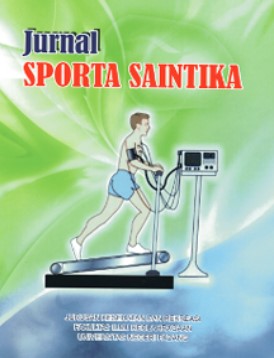Hubungan Aktivitas Fisik Dengan Tingkat Kebugaran Jasmani Peserta Didik
Abstract
The research was conducted to analyze the relationship and contribution of physical activity to the physical fitness level of 10th-grade students at SMA Negeri 3 Mojokerto. The design applied was a correlational study with a quantitative model. The Physical Activity Questionnaire-Adolescents (PAQ-A) was the instrument used to assess physical activity, and the Test of Physical Fitness for Students of Nusantara (TKPN) was the instrument used to assess physical fitness. The subjects were selected using a simple random sampling technique and calculated utilizing the Slovin formula to determine the total subjects. Based on the Slovin formula calculation, the subjects used amounted to 155 students class X of SMA Negeri 3 Mojokerto. The investigation used Spearman Rank Correlation data analysis to test the correlation between the two variables. The findings showed the significance value of the correlation between physical activity and physical fitness level was 0.000 < 0.05. The correlation coefficient between the two variables was 0.307 (positive direction), meaning that the better the physical activity, the higher the physical fitness level of the students. Based on the correlation coefficient value (r) of 0.307, it was interpreted according to the correlation coefficient guidelines as indicating a moderate level of relationship.
Downloads
References
Amin, N. F., Garancang, S., & Abunawas, K. (2023). Konsep Umum Populasi Dan Sampel Dalam Penelitian. Jurnal Pilar, 14(1), 15–31.
Anjarwati, R. (2019). Hubungan antara aktivitas fisik dengan indeks massa tubuh mahapeserta didik PJKR Semester 4 di Fakultas Ilmu Keolahragaan Universitas Negeri Yogyakarta Tahun 2019. Universitas Negeri Yogyakarta.
Darmawan, I. (2017). Upaya Meningkatkan Kebugaran Jasmani Peserta didik Melalui Penjas. Jip, 7(2), 143–154. http://ejournal.unikama.ac.id/index.php/jrnspirasi
Dewa, A. K., & Winarno, M. . (2023). Hubungan Aktivitas Fisik Terhadap Kebugaran Jasmani SMA Islam Al Ma`Arif Singosari. GYMNASIA: Jurnal Pendidikan Jasmani Olahraga Dan Kesehatan, 2(2), 116–129. http://jurnal.anfa.co.id/index.php/PJKR
Erfan, M. (2017). Peran Guru Terhadap Kebugaran (Kesegaran) Jasmani Peserta didik. Seminar Nasional Pendidikan Olahraga, 170–178.
Erliana, E., & Hartoto, S. (2019). Hubungan Aktivitas Fisik Terhadap Tingkat Kebugaran Jasmani Peserta didik. Jurnal Pendidikan Olahraga Dan Kesehatan, 7(2), 225–228.
Ferdianto, T. P. (2017). Hubungan Aktivitas Fisik Harian Dengan Tingkat Kebugaran Jasmani (Studi Pada Peserta didik Kelas VIII SMP Negeri 2 Candi, Sidoarjo). Jurnal Pendidikan Olahraga Dan Kesehatan, 05, 925–928.
Fildzah, F. M. P., & Kurniawan, A. W. (2023). Tingkat Kebugaran Jasmani Peserta didik Kelas X Di Sekolah Menengah Atas Negeri 2 Kota Pasuruan. Jurnal Master Penjas & Olahraga, 4(1), 290–297. https://doi.org/10.37742/jmpo.v4i1.81
Kusyandi, A., Murniviyanti, L., & Rizhardi, R. (2021). Perbedaan Tingkat Kebugaran Jasmani Peserta didik. Jolma, 1(1), 1. https://doi.org/10.31851/jolma.v1i1.5365
Maksum, A. (2018). Metodologi Penelitian Dalam Olahraga. Unesa University Press, 298.
Nugroho, R. A. (2020). Pengaruh Kualitas Pelayanan, Kualitas Produk Dan Citra Perusahaan Terhadap Kepuasan Pelanggan (Studi pada Nasabah PT Prudential Indonesia, Jakarta). Purposive Sampling, November 2018, 23–25.
Pratama, R., Jumain, & Buluban, A. (2018). Survei Tingkat Kesegaran Jasmani Peserta Didik Kelas X Sma Negeri 3 Palu. 0383, 74–81.
Pratiwi, R. Y. (2023). Kesehatan Remaja. Puskesmas Gunung Bungsu. https://pkm-gunungbungsu.dinkes.kamparkab.go.id/artikel-detail/6/kesehatan-remaja
Rohmah, L., & Muhammad, H. N. (2021). Tingkat Kebugaran Jasmani dan Aktivitas Fisik Peserta didik Sekolah. Jurnal Universitas Negeri Surabaya, 09(01), 511–519.
Suatrean, V. V., Munandar, W., & Awaluddin. (2022). Survey Tingkat Kesegaran Jasmani pada Peserta didik Kelas XI SMA Negeri 1 Maluku Tenggara. Kumpulan Artikel Pendidikan Anak Bangsa, 2(1), 65–83.
Suryadi, D., Suganda, M. A., Sacko, M., Samodra, Y. T. J., Rubiyatno, Supriatna, E., Wati, I. D. P., & Okilanda, A. (2023). Comparative Analysis of Soccer and Futsal Extracurriculars: A Survey Study of Physical Fitness Profiles. Physical Education and Sports: Studies and Research, 2(1), 59–71. https://doi.org/10.56003/pessr.v2i1.179
Wanjaya, V. C. G. (2019). Hubungan Aktivitas Fisik dengan Tingkat Kebugaran Jasmani Peserta didik Kelas XI SMA NEGERI 1 Srengat Blitar. Pendidikan Jasmani, 07, 433–437. https://jurnalmahapeserta didik.unesa.ac.id/index.php/jurnal-pendidikan-jasmani/article/view/31291/28402
Weedon, B. D., Liu, F., Mahmoud, W., Burden, S. J., Whaymand, L., Esser, P., Collett, J., Izadi, H., Joshi, S., Meaney, A., Delextrat, A., Kemp, S., Jones, A., & Dawes, H. (2022). Declining fitness and physical education lessons in UK adolescents. BMJ Open Sport and Exercise Medicine, 8(1). https://doi.org/10.1136/bmjsem-2021-001165
Wintle, J. (2022). Physical Education and Physical Activity Promotion: Lifestyle Sports as Meaningful Experiences. Education Sciences, 12(3). https://doi.org/10.3390/educsci12030181

This work is licensed under a Creative Commons Attribution-ShareAlike 4.0 International License.


